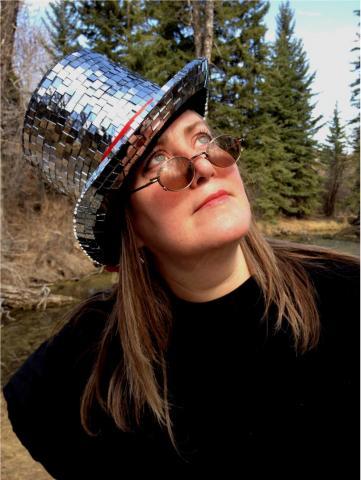Photo: Jamie Gray
BACHELOR OF FINE ART IN GLASS, 2009
ALUMNI DISCOVERY INITIATIVE, INTERVIEW BY VANESSA NELSON, 2015
Vanessa NELSON: When did you graduate ACAD? (And what was it called then?) What was your major? Do you continue to work in this area or did you change areas of interest?
Jamie GRAY: It was ACAD and it was 2009. I was a mature student – I’m still a mature student. My major was glass, and I’m still strictly glass, although I have to say that I’ll use whatever media I need to get the point across because my work is narrative, sometimes conceptual, so I don’t always use glass if that’s not the material that is needed for that particular piece. But I love glass, so I usually end up using it in one way or another.
NELSON: A lot of graduates use the ACAD degree as a creative stepping stone. So, what do you do?
GRAY: Definitely ACAD was a stepping stone. I needed a BFA to go get an MFA, and that’s what I’m doing right now, six years later, at the University of Edinburgh. They have a glass department so I can get an MFA specific to glass.
I was never absolutely sure I would continue on with a Master’s degree, and it would have been fine to get my BFA and stop there, as since the completion of [my BFA] I’ve managed to carry on with my studio practice. I have been doing a bit of teaching, too. However, my hope with getting an MFA is that I can teach at a university level. No matter what, I’ll always continue on with a studio practice.
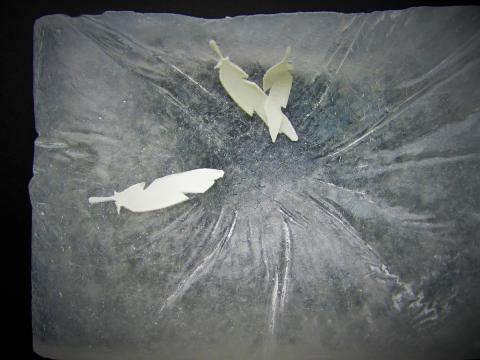
Feather Pillow
NELSON: How did you decide to pursue an education at ACAD?
GRAY: I knew I wanted to do glass before I entered ACAD. Prior to applying, I knew I was an artist of some sort. By the time I entered ACAD, I had taken some foundation courses in a bunch of different media — painting, metals, fibre — and had decided on glass. So, I went to ACAD specifically to do glass after already having a sense of working with the medium for 12 years. It was very intentional.
I started out as many glass artists do: by working in stained glass. It’s easy to do in a tiny studio space. I eventually became bored with the 2D aspect of [stained glass] and looked at kiln forming, with the idea that I could take glass to a level that was more sculptural.
I also started taking night classes from Bonnie Houston who is a Calgary glassblower, which taught me that I had a great interest in hot glass. All this led up to my decision to finally pursue ACAD full-time for a BFA in glass. I had always wanted to go and wasn’t able to right out of high school. I have been lucky because my husband and daughters have been hugely supportive through all this.
NELSON: How has what you do evolved since graduation? How did your education at ACAD shape your career?
GRAY: When I entered the glass program at ACAD in 2005, it was quite centered around blown glass. A lot of people were going there to blow glass, in part because it’s a lot of fun.
One thing that ACAD did for me was teach me to blow glass well. But also, because there were quite a few kilns at the college, the opportunity existed to do some more formal kiln-forming. Over the four years that I was there, more people became interested in working in the kilns, and the department was open to that. We were able and encouraged to explore.
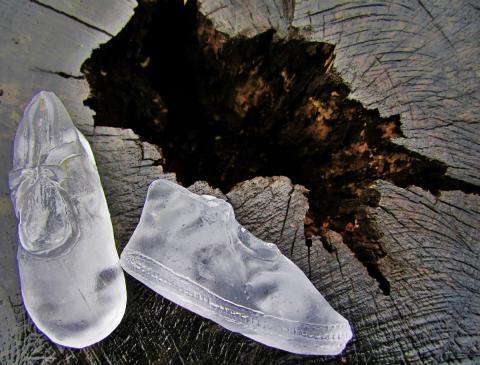
For sale: baby shoes, never worn.
Now that I’m in a European university, I appreciate so deeply my ACAD education, because we were taught technical hands-on craftsmanship. In craft, the techniques are extensive and you have to be able to do them well. ACAD teaches all of that. So, I felt well-equipped, once I came out of my four years at ACAD, to go and work as a glass blower, kiln former, or start my own studio. I am grateful for that now more than ever.
Teaching models are different everywhere, but it looks to me like European universities focus more on design and less on the material, so I’m grateful that I have been taught the ability to not only design my work but see its making through to completion. I know now from being in a European university that the teaching model is quite different; it’s more design-focused. I’m grateful that I have hands-on skills from ACAD and design experience through the University of Edinburgh. The combination of the two is incredibly valuable to me.
NELSON: What would you like to be recognized for?
GRAY: I would like to be recognized for having an excellent teaching style. I’d like to be known as a motivator or encourager. That’s important. I had some top-notch instructors at ACAD. Really excellent instructors. Tyler Rock, and Norman Faulkner who founded the glass program and carved the department out of the ceramics department. Natali Rodrigues, Robert Geyer, Marty Kaufman, Jim Norton – they are all amazing. I’m so grateful to have been under their tutelage. I want to be that person that goes on to teach and is an encouraging motivator for others; I want to be someone that opens doors for them, and that watches them find their pathway.
That’s important to me, but it also may be that I will be more of a maker than an instructor and so I’d like to be known for the work I make and, more importantly, why I make it. My work is about the prairies. I want to be known for that because I’ve decided very intentionally to “bloom where I’m planted” and that means making work about where I’ve grown up. The prairies are big, beautiful, and interesting. There’s a lot of humour to be found in the difficulties of growing up an Alberta farm kid, and I want to make full use of that in my work. I’d like other people who’ve grown up in my same situation to look at my work and smile in recognition of shared experience. It’s friendly, and I’d like to be known for that.
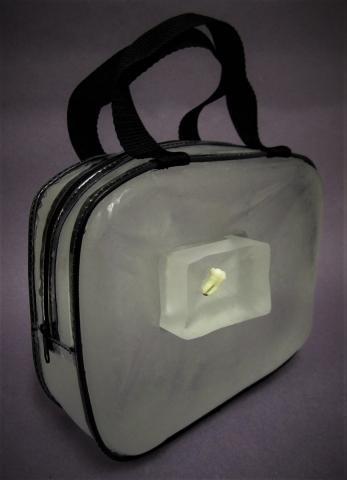
Baggage
NELSON: Given your experiences, what advice would you give a student when it comes to establishing a creative business?
GRAY: In some ways that’s a difficult question because I often think that the business of art should be secondary to the pursuit of free creation, but of course practicalities dictate otherwise. But one thing is for sure: you have to be willing to pay your dues. By that, I mean get involved in your professional associations, volunteer time in them, and be willing to do that for years. That gets your face known, your name known, and, eventually, your work known. And it’s great for the professional associations, so it’s a win-win.
Also, go to every exhibition opening you can. Again, let your face be seen. Talk to as many people you can stand to talk to; it can be hard if you’re not a social butterfly. You have to force yourself to get out there and be known by the arts community. Don’t be too reclusive.
Build up your studio piece by piece. As is especially the case for a crafts-based art practice, the required machinery can be expensive and large. Be willing to take secondhand equipment; learn how it works well enough to be able to take it all apart and fix it. Be willing to do trades. Be willing to take the proceeds of any money you make and put a large portion of that back in your studio. Buy and wear second-hand clothing. Have a small garden. Live simply.
Finally, keep in mind that you can make yourself a studio out of the tiniest little space; a corner of the garage or the basement. Just go do your work there consistently. It’s too easy for new emerging artists to just drop right off because they think they need a public studio space. They have an expectation of it. But you don’t have to be out in a public studio space. It can be great if you can afford it but begin by building the space wherever you can. Then be disciplined enough to go there.
NELSON: What insights did your four years at ACAD give you when looking at things?
GRAY: Not only did we have our technical/studio classes but we also had academic classes. Even though art students don’t typically like to learn about art history, the business of art, or whatever, you learn how to see things in a different way by taking those classes with other creative people and having discussions within that setting. Academic and theory courses can add so much to your education. It’s so important to learn how to become a critical thinker.
NELSON: After graduation, what obstacles did you encounter and how did you overcome them?
GRAY: I graduated 6 years ago from ACAD, and it’s taken this much time to come around to doing an MFA. I’d say I had the common obstacles. The first was cutting the cord between me and the school. After graduation you no longer have access to the school. You’ve had your time and it’s time to go. It’s hard to leave a wonderful atmosphere of creativity and built-in critique – there are galleries, there’s a plethora of art, and all of a sudden, you’re no longer part of it.
It’s difficult to transition from not being expected to earn an income to having to think about earning an income. Not that making money is the most important part, but it is essential. The transition from student to practicing artist was difficult. I found, when people asked, “what do you do?” it was sometimes difficult to give myself the label of “artist.” It’s maybe not [difficult] for everyone, I suppose, but for some of us it’s really hard to admit. It’s becoming easier now, but these days I find it’s easier to say I’m a “sculptor” than an artist because when you use the term “artist,” people usually think “painter.”
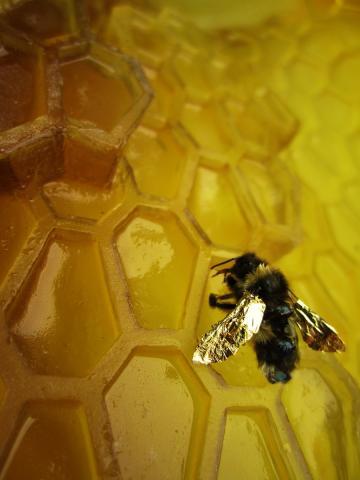
Telling the Bees
NELSON: How could you imagine ACAD supporting our alumni?
GRAY: Firstly, I have to say that it’s possible that the things I’ll suggest may already be happening and I just don’t know about them, but here are my two cents. It would be good if the alumni association helped alumni with job opportunities, and they may be. I follow ACAD’s Facebook page, and they post some opportunities, but I feel like there may be more, or that there is a better way of connecting opportunities and keeping alumni connected. I’d like to see a way for people to stay connected after graduation, too, because I think if you make sure that artists stay in some sort of community, they have a better chance of continuing on with [their practice].
NELSON: What do you feel is the role of ACAD and our alumni in shaping our cultural and economic prosperity?
GRAY: That’s a big question. I think it’s important that we make sure that our emerging artists don’t get discouraged and drop off too quickly. The statistics are discouraging, something like after 10 years past graduation only 10% of grads are still working in the arts industry. It’s very bad. Very discouraging.
It’s unfortunate to invest this time and money into a degree, only to have such a high probability after 10 years of not using it. On one hand, I’m not surprised because there is so little support for the arts overall. It’s not seen as essential, but if you look around, art is everywhere. And if we, as a society, didn’t have the arts we’d learn quickly that we would really miss it.
I think it’s important that we, as a society and as alumni, continue to support the arts and champion its importance. We must also begin and continue to mentor emerging artists so that we don’t lose them to attrition. New artists and the arts on a whole need to be well supported. That’s part of our role.

Edinburgh Mirrored Cobble Stones
NELSON: Why do you think that creativity matters in the big picture?
GRAY: Without creativity, we merely exist. With it, we live. If we don’t have creativity, we’re just moving along. Creativity allows for the possibility of looking at things in different ways; it functions to pique people’s interests. It promotes multilayer thinking and better discussions. In short, art enriches our experiences as humans.
As artists we should all know why creativity matters. It’s a really important question because I don’t think we artists ask ourselves this often enough. We should all know why we are doing what we are doing. Without asking this question, we are working in a vacuum.
Why do we care if anyone sees our art? That is usually the end point; it’s out there for discussion or dissection. Public response is important to what we are doing. We quite often don’t think that far ahead; we don’t consider this aspect of making often enough. I think it’s important that we do. Artists are quite often social activists. So maybe we’re making art to provoke or highlight a certain viewpoint or response, and that’s why creativity matters. As an artist it’s important to ask these questions for yourself.
NELSON: Where does art fit into your future?
GRAY: It is my future.
